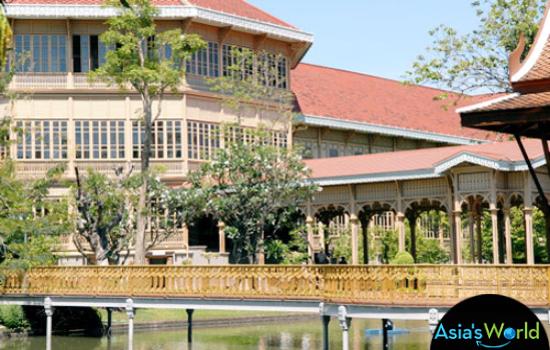Vimanmek Mansion Museum
Palace Visiting Details:- Location: Dusit Palace Grounds, off Ratchavithi Road (behind the Parliament Building) Dusit, Bangkok 10300
- Telephone: 02 – 280 – 5928
- Hours: Open every day from 9.30 am to 4 pm (last entry is at 3.15 pm)
- A Guided Tour of Mansion Museum takes 1 hour
- Allow half a day if you want to visit the whole complex, including other Palace buildings, photographic galleries, the Old Clock Museum and the Ancient Cloth and Silk exhibition, and the exhibition detailing the history of the royal elephants
- Admission: Adults 100 baht
- As this is a Royal residence, proper modest dress is required and enforced

Vimanmek Mansion Dusit Bangkok
- Vimanmek Mansion is part of a whole complex of buildings in the Dusit Palace grounds.
- It was built by King Chulalongkorn (King Rama V, 1869 – 1910) as a summer retreat in 1901, and he resided here until 1906. After his death in 1912, the building was virtually unoccupied for a period of fifty years. In 1982, the hitherto neglected Mansion was renovated for use as a museum to commemorate King Rama V by displaying his photographs and collection of artwork and handicrafts of the Bangkok period.
- Over the years more than 20 structures of the old Dusit Palace have been restored, and now display everything from ancient artefacts of Thailand's prehistory to contemporary photographs donated by His Majesty the King. It has now become a large complex of museums where the buildings form part of a collection themselves.
- Vimanmek Mansion is the world's largest golden teak wood mansion with its elaborate architectural style reflecting a western influence. The building itself is aesthetically pleasing, and although European in style, it was constructed according to traditional Thai building methods, without the use of nails.
- The building has two right-angled wings, each three stories high and 60 meters long. An enclosed veranda runs around the whole exterior of the mansion, which serves to filter out the direct sun, and allow for air circulation. There is a four-storey octagonal section at the north end, which was the residence of King Rama V. The rooms of this residence have been restored to their original condition, including the King’s bedroom, private study and bathroom. The living room and audience hall on the lower floors have been furnished in European style.
- For the visitor, this museum gives a glimpse of Thai history at the turn of the century and the artefacts displayed inside it reflect the influence of Europe and the western world at that time in Thailand. King Chulalongkorn himself was the first Thai king to visit Europe and he made several trips, which established strong links with the west. He acquired many exquisite works of European art, including a collection by the Russian jeweller, Carl Faberge, which can be seen. European glassware became very much in fashion during his reign. The unusual and colourful glazes of the Art Nouveau era in Europe appealed to the Thai taste and much glassware was imported, of which there is a small selection here.
- Although there is a beautiful collection of Chinese blue and white porcelain from the Ming dynasty on exhibit, there are many items of European porcelain of different shapes and forms which indicates again the spread of western culture into the Thai way of life. There are in total 31 exhibition rooms including displays of Thai silverware, gold and silver ware called "Ta Thong'', ceramics, crystal and ivory.






